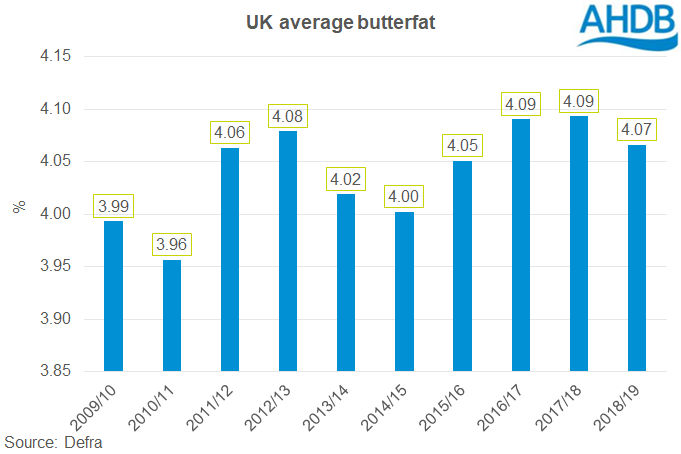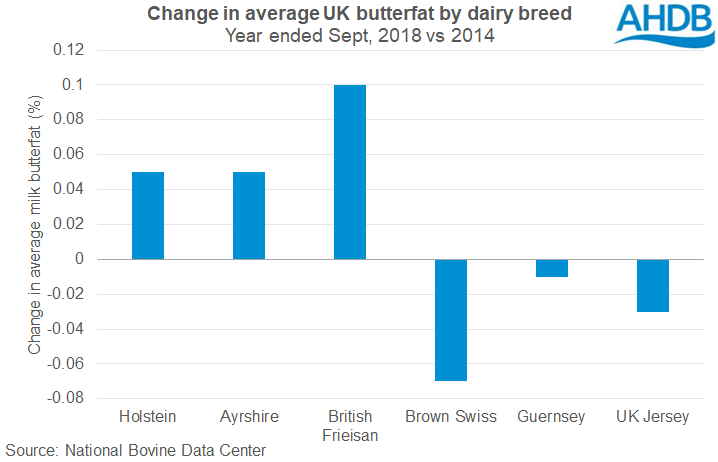How have changing genetics affected butterfat levels?
Thursday, 6 February 2020
By Felicity Rusk
Over the past decade, the average butterfat content in UK milk has been steadily rising. The 2019/20 season so far has already recorded the highest average UK butterfat content since records began. Butterfat content varies from season-to-season, reflecting short-term impacts from drivers such as dietary changes and fluctuations in cow condition. However, the rise in butterfat over the longer term is likely a reflection of genetic changes.

Improved breed performance due to genetic improvements is a key factor influencing butterfat content. According to the National Bovine Data Centre, the average butterfat content of milk from Holsteins and British Friesians, which together account for 78% of the national milking herd, has increased by 0.05% and 0.10% respectively between 2014 and 2018.

Furthermore, over the last couple of years, there has been a large increase in the number of crossbred animals in the milking herd. The shift away from the Holstein-Friesian breeds, renowned for their yields rather than milk solids, to more crossbred cows is likely another factor in the increase in average butterfat.
Based on our estimates*, we would expect genetic improvements and the change in the breeds to have the ‘potential’ to have increased average butterfat by 0.07% and 0.01% respectively, between the 2014/15 and 2018/19 seasons. As such, our expectations align well with the recorded improvements in average butterfat during this period (0.06%).
However, our estimates only represent the ‘potential’ increase in butterfat. Butterfat can be manipulated relatively easily in the short-term, reflecting the conditions of that particular season. Therefore, it is not surprising that the recorded increase between the 2014/15 and 2018/19 seasons did not fully align with our estimate.
*Our estimates are based on breed population data from the British Cattle Movement Service (BCMS), and average butterfat content for most breeds, sourced from the National Bovine Data Centre and a number of breed club websites. Specified crossbreeds (e.g. Holstein X, Jersey X) were assumed to have the same average butterfat as their pedigree counterparts. Defra’s average UK butterfat content was used for non-specified categories (e.g. crossbred dairy cow) and when specific breed information could not be found.
Sign up to receive the latest information from AHDB.
While AHDB seeks to ensure that the information contained on this webpage is accurate at the time of publication, no warranty is given in respect of the information and data provided. You are responsible for how you use the information. To the maximum extent permitted by law, AHDB accepts no liability for loss, damage or injury howsoever caused or suffered (including that caused by negligence) directly or indirectly in relation to the information or data provided in this publication.
All intellectual property rights in the information and data on this webpage belong to or are licensed by AHDB. You are authorised to use such information for your internal business purposes only and you must not provide this information to any other third parties, including further publication of the information, or for commercial gain in any way whatsoever without the prior written permission of AHDB for each third party disclosure, publication or commercial arrangement. For more information, please see our Terms of Use and Privacy Notice or contact the Director of Corporate Affairs at info@ahdb.org.uk © Agriculture and Horticulture Development Board. All rights reserved.

